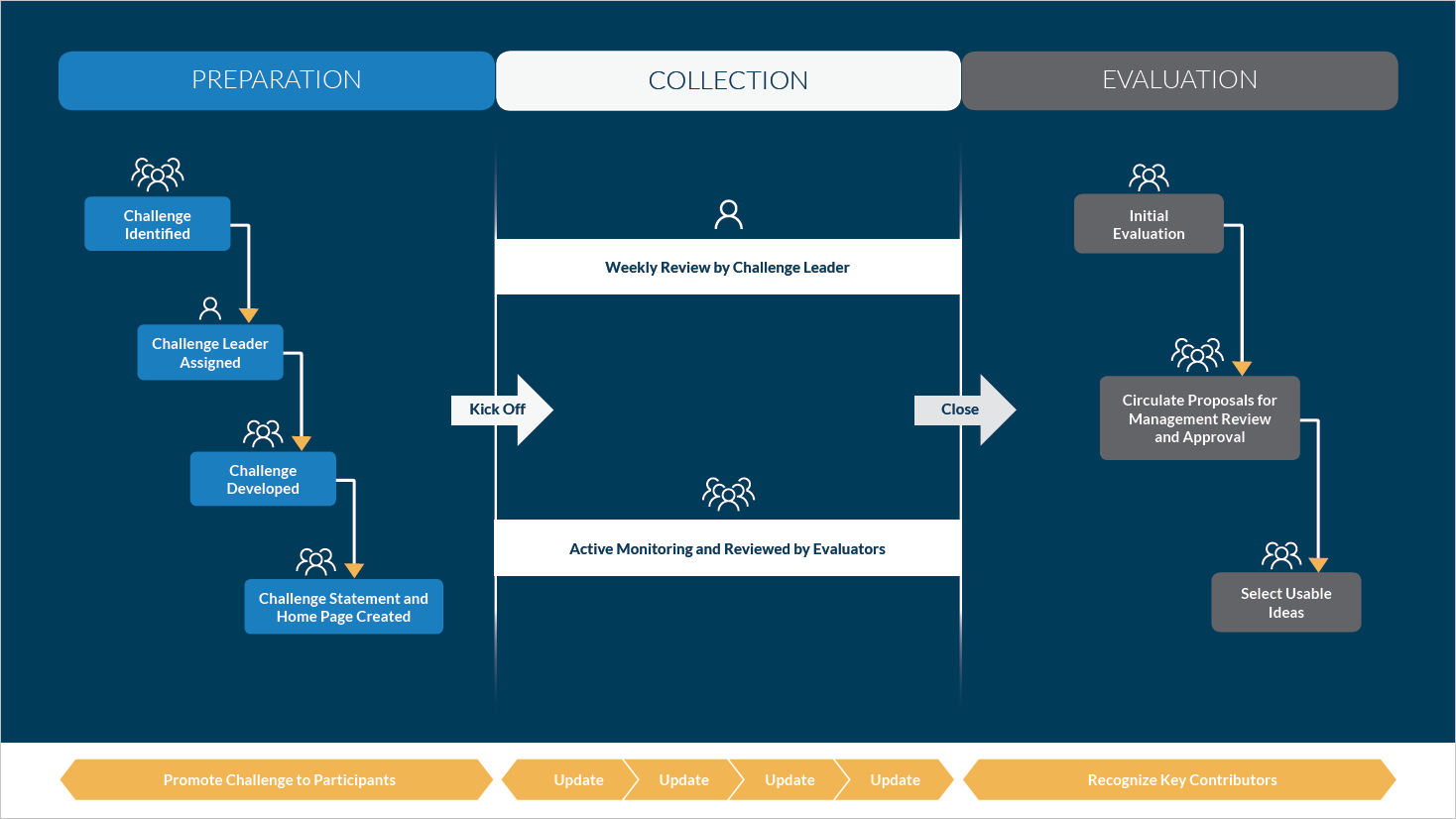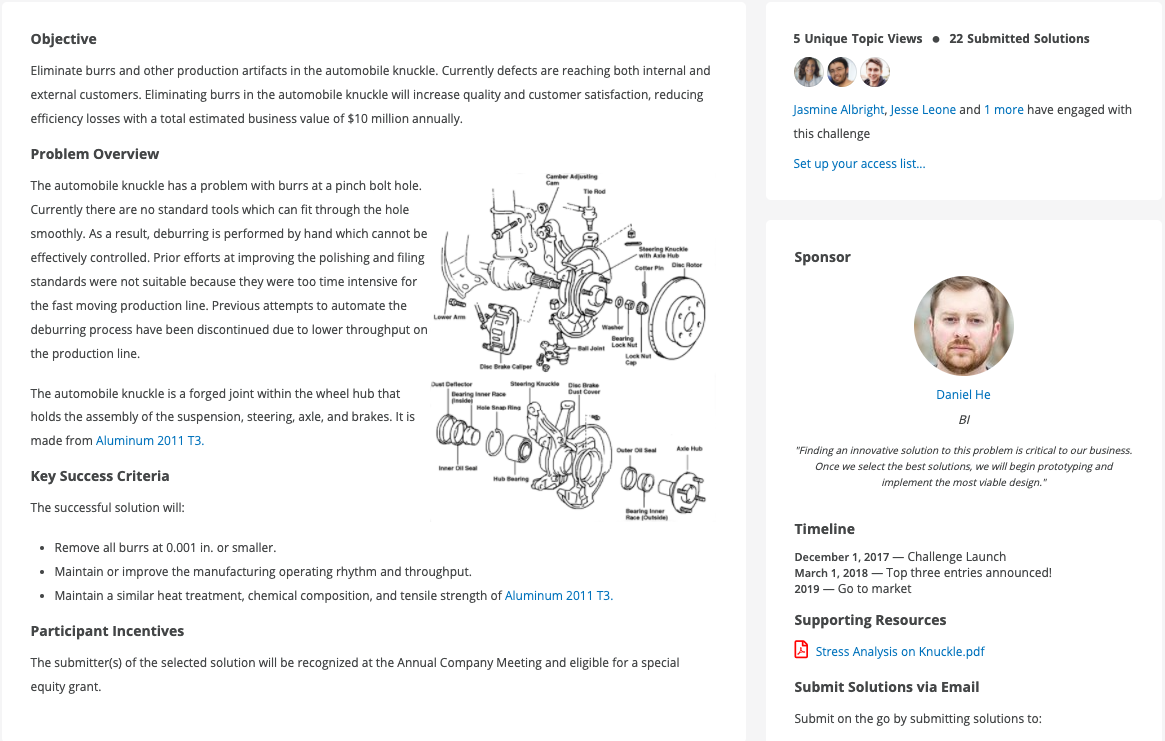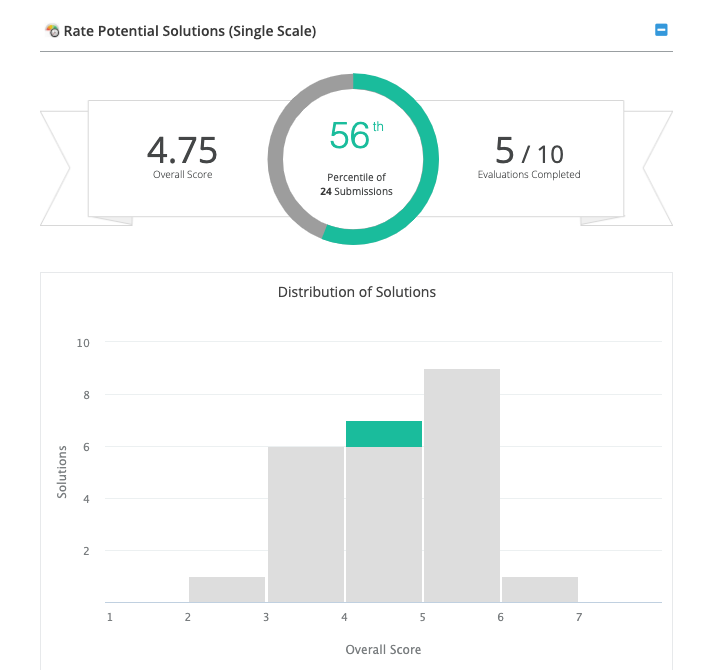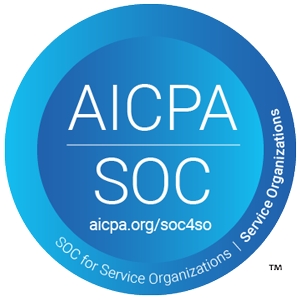A veteran innovation manager shares best practices for maximizing the value of challenge contests
With the quickening pace of business, differentiation no longer lies exclusively in optimizing process and production. Rather, an organization’s ability to continuously innovate is what grows revenue and opens new opportunities. In-house innovation programs tasked with structuring and managing the innovation process often turn to challenge contests to ignite the embers of great ideas from across the organization. But announcing a challenge is one thing, hosting a successful one, much less an ongoing series of challenges, is an entirely different proposition.
“Challenges should align with identified needs of the business. Without that alignment, ideas—no matter how good they are—may never move to implementation.”
The preparation, planning, and management required to ensure a successful challenge doesn’t just happen. Creating a foundation for productive challenge contests begins long before a challenge is announced, according to Greg Thompson, former corporate technology director for Autoliv. Thompson, who led innovation programs at the automotive safety supplier for more than a decade, says, “Challenges should align with identified needs of the business. Without that alignment, ideas—no matter how good they are—may never move to implementation.”
In his time with Autoliv, Thompson aligned challenges with known needs and structured them so that funding and support for winning ideas were already in place before a challenge contest began. That ensured promising ideas became executable projects and, critically, valued the efforts of those participating by ensuring effort mapped to results. “You shouldn’t ask questions you’re not committed to solving,” says Thompson. “Ideas are very personal to those submitting them and if you don’t take it seriously, you disrespect people.”
Like many who lead innovation efforts, Thompson came to the role indirectly. He recalls, “I was running product development and the CTO tapped me to work on boosting brainstorming.” Armed with a mandate, he identified two challenges to evaluate the Brightidea platform for surfacing and managing ideas. The results of the 2-challenge pilot proved so successful that the CTO directed rolling out the program across all 10 of Autoliv’s product groups.
Ensuring there’s a foundation in place to move ideas forward is what distinguishes real innovation from innovation theater according to Thompson. He also recommends rotating challenge events across different groups or units of an organization to stave off challenge fatigue. Savvy sequencing of challenges can keep a continuous pipeline of promising ideas flowing without burning out any particular group and keep it fresh for the community.
Thompson continuously refined his approach to running challenge contests over several years. A result of that experience is a 3-phase approach he recommends that can be used as a guide for any organization to run a successful challenge.

3 Phases of a Successful Challenge
Each of the 3 phases—preparation, collection, evaluation—has distinct elements that require different approaches.
Preparation Phase
The preparation phase is when the specific challenge is framed in the form of a challenge statement that focuses the challenge around an agreed-upon need that already has resources and funding in place. Reviewing a challenge statement beforehand builds support for the challenge internally. It also sets the stage for winning ideas to be essentially pre-sold because everyone is bought into the problem they address.

Thompson stresses the importance of clear communication and expectation setting. “Don’t let the technical people write the final challenge statement or it won’t be broadly understood,” he says. Thompson suggests road-testing challenge statements with non-technical audiences and even those outside the organization to ensure that the ask is clear and easily understood.
Having evaluators review challenge statements as well the evaluation criteria in the prep phase can not only help make statements better, but it also ensures the evaluators are up to speed well before they need to review and assess submissions. Lastly, promoting the upcoming challenge in existing communication vehicles serves to build anticipation and set expectations about participation and the criteria for success.
Collection Phase
The central phase of a challenge is when the contest is live and ideas are being submitted. Though the collection phase is the quietest for challenge contest managers, it shouldn’t be silent. Throughout the collection phase, Thompson recommends regular communications for participants to spur submissions and keep awareness high. He also advises weekly meetings with subject matter experts (SMEs) to review submissions—these frequent checks, can not only enfranchise experts but also prepare them for the coming evaluation period when ideas are scored.
Based on his experience, Thompson highly recommends reviewing all submissions to date at the midpoint of the collection phase. That midway check allows challenge managers to gauge how submissions match the intended focus of the challenge and adjust if needed. “Sometimes you run a challenge wide open to get a breadth of ideas and other times it’s laser-focused,” he says. “A midpoint evaluation allows you to narrow or widen the lens while the challenge is still live.” Another significant component of a midpoint check is assessing the sources of submissions; depending on who has submitted to date, challenge managers can prompt specific groups or regions who are underrepresented to submit.
Evaluation Phase
After the challenge closes, the hard work of reviewing and scoring the submissions can begin. If the expectation setting and checkpoints that Thompson recommends in the first two phases work as intended, evaluators can get started quickly. A review of acceptance criteria can support alignment among evaluators and also allows the option to add any emergent criteria identified during the collection phase that’s needed to evaluate submissions.

By design, challenges attract a range of ideas, and eliminating those at the margins is an efficient first step in the evaluation process according to Thompson. “In every challenge, there are ideas that have clear feasibility issues,” he says. One approach to culling these outliers is an initial binary yes/no review, which sets the stage to focus on detailed scoring of potential contenders. After ideas have all been score carded, Thompson recommends the final evaluation be subjective to balance a purely quantitative “Metrics can often lead you to something safe and that’s not the point of a challenge.” result. He says, “Metrics can often lead you to something safe and that’s not the point of a challenge.” The subjective review also allows evaluators to group complementary ideas, which can yield better results post-contest when winning ideas move toward execution. “In almost all cases, what was used became a hybrid of multiple related ideas,” recounts Thompson.
![]()
A successful evaluation process not only identifies winning ideas but also reinforces the value of participating in challenge contests. Recognition of winners and participants was a key component of the program Thompson led. “We not only recognized the winning ideas, but we also recognized the craziest idea so that we were applauding abstract thinking,” he says. Recognition will vary by organization, but Thompson recalls that plaques, presentations, participation in company events, time with executives, and even hand-written thank you notes from leadership were popular forms of recognition.
After a challenge contest is complete, winning ideas move on to execution, but the other submissions still have value according to Thompson. He says, “We kept all the ideas on file and that helped craft future challenges—particularly when a topic was repeated.”
In reflecting on the impact of challenge contests on the innovation process, Thompson cites the sources of submitted ideas as perhaps the greatest value. “In almost every challenge, most of the ideas came from non-domain specialists who never would have been asked the question in the normal course of business,” he says. “Those problems likely would have been solved anyway, but challenge injected fresh and different ideas about how to do it.”
Learn how you can tap the best minds across your organization to Solve important problems.


